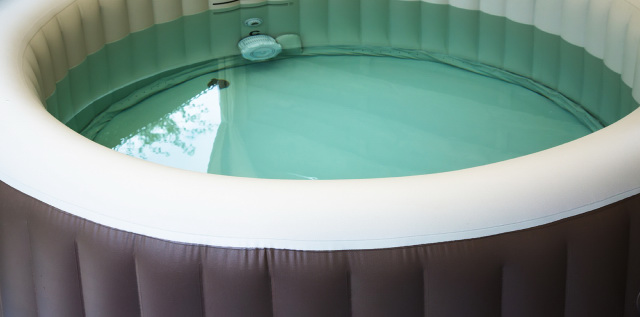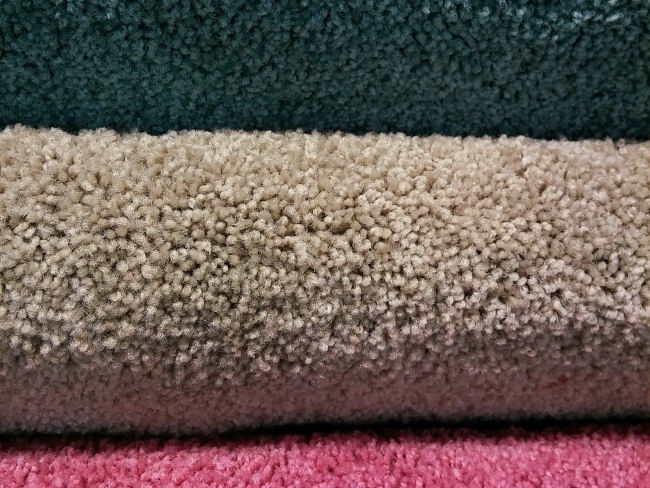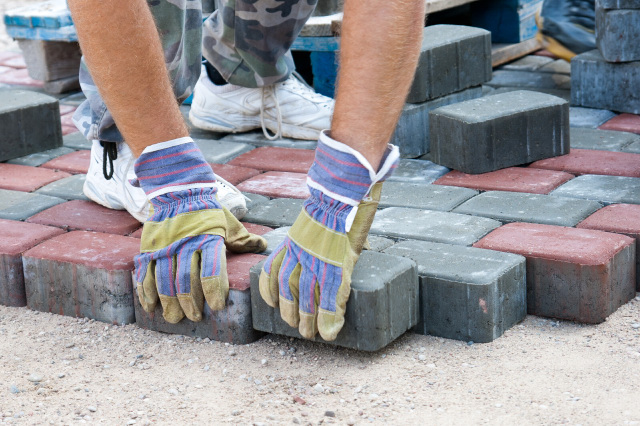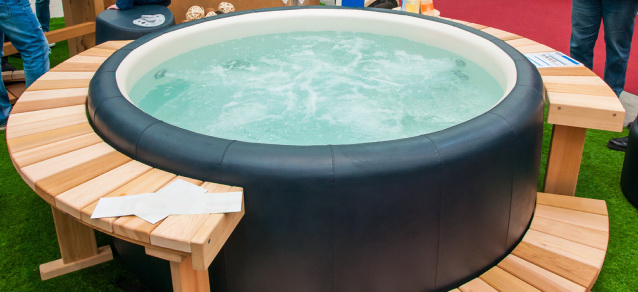An inflatable hot tub is one of the best ways to enjoy your garden during the summer. However, you need to ensure that you have something appropriate under it.
There are several options for finding a suitable material to put underneath, but how do you choose?
Ideal materials to put under inflatable hot tubs include interlocking foam tiles or rubber mats. Choose a soft, thick material with thermal insulation properties that will protect the bottom of the hot tub from abrasions and punctures. A softer material will provide a comfortable feel for the swimmers’ feet.
Keep reading for a full rundown of some common hot tub and pool underlayment materials you can use under your inflatable hot tub.

Article Contents
What Type of Base or Pad is Safe for Your Inflatable Hot Tub?
Before we get into what you should put under your hot tub, it’s important to choose the right surface or pad to put your hot tub on.
Some of the best base options for inflatable hot tubs are:
- Concrete pads
- Pavers
- Crushed gravel or stone
Decks may not be strong enough unless they have been reinforced. And grass can sink with the weight of the tub.
The best option is usually a concrete pad. It’s usually strong, smooth, and level. They’ll be no sharp objects to piece your inflatable tub, no bugs or animals to burrow around it, and no grass to grow up and around it.
Why It’s Important to Choose the Right Material to Put Under Your Inflatable Hot Tub
Choosing the right material to put under your inflatable hot tub is an important choice. The right material means:
- Less chance of punctures or tears
- Nicer feeling under the feet
- Easier to clean
- Prevents abrasions
- Protects it from grass, bug, and animal damage.
Considerations When Deciding What to Put Under an Inflatable Hot Tub
What factors do you need to take into consideration when choosing something to go under your tub? There are a few things including:
- Cost
- Durability
- Comfort
- Protection
- Insulation
Don’t just consider the cost when deciding what to put under your hot tub. You likely invested quite a bit of money so I’m guessing you probably want to prolong the life of your purchase.
Protects from Punctures and Tears
Blow-up hot tubs can be a little delicate and are susceptible to punctures and tears. Using thick foam tiles or carpet under it is a great choice to protect the base from possible damage.
Feels Soft Under the Feet
The material you use will also affect how the bottom of the hot tub feels on your feet. If you only use pavers and a groundsheet, it could feel quite hard. Many people prefer the feeling of foam tiles or carpet as it’s softer on the feet.
Insulates The Hot Tub
And lastly, you’ll want to make sure you use something that insulates the tub from the cold ground. There will be a massive difference in heating efficiency and heat retention if you use insulation.
Materials to Go Under an Inflatable Tub
1. Interlocking Foam Tiles
Foam tiles are an ideal choice to go under your tub. They are sturdy, strong, relatively inexpensive, and easy to work with.
- Perfect to put underneath Intex pools & inflatable hot tubs
- Smooth, strong & durable
- Easy to cut, fit & install
They also provide excellent insulation, and cushioning under your feet and will protect the bottom of your hot tub.
Pros
- Feel good under the feet
- Easy to work with
- Protects the bottom from punctures
- Good insulation
Cons
- Doesn’t breath
- More expensive than other options
2. Reflective Insulation
It’s super important to insulate the bottom of your inflatable hot tub. Try using a product like this directly on your pad and then laying foam tiles on top.
Insulation like this is a little too thin by itself and will feel hardish under your feet. But combine it with foam tiles and you get the benefits of a well-insulated tub and a nice feel under your feet.
- Reflects 95% of radiant energy & acts as a vapor barrier
- Insulates hot & cold, unaffected by moisture
- Excellent sound barrier, effectively reducing noise
Pros
- Excellent insulation
- Easy to install and work with
- Readily available
Cons
- Too thin by itself
- Can feel hard under feet
3. Carpet
So you heard maybe carpet could be good to go under an inflatable hot tub. Is it?
Carpet is an excellent cost-effective solution that will provide top-notch protection from sharp objects piercing the tub’s floor. It can also be cheap or even free. But it doesn’t provide much in the way of insulation and is susceptible to mildew and mold.
It also doesn’t have longevity like foam or rubber.

Pros
- Can usually find it for free
- Protects the bottom from punctures
- Feels food under feet
- Breathable
Cons
- Susceptible to mold and mildew
- Harder than foam tiles
- More difficult to work with
- Not good insulation
4. Underlayment or Carpet Padding
When laminate flooring is installed, a foam sheet is usually installed between it and the subfloor. It comes in rolls and can be used to go under your inflatable hot tub. It won’t provide much protection for the bottom of the inflatable tub, and it is quite hard on the feet.
Carpet padding is installed between the floor and the carpet to help it feel nicer under the feet. It’s a better choice for putting under your hot tub than underlayment. Again, it won’t provide a lot of protection under the tub.
To give it a softer feel under your feet, you could double it up and use multiple layers.

Pros
- Cheap
- Easy to install and work with
- Readily available
Cons
- Little protection for the hot tub vinyl
- Thinner and feels harder under the feet
- Average insulation
5. Paving
Paving can be used between your hot tub and the ground however it has to be done correctly.
Paving should be several inches thick and need to be laid on a solid surface like concrete or a thick crushed gravel pad. You’ll also need to cement them in to prevent movement.

Due to the weight of a hot tub (several thousand pounds), it’s not recommended lay pavers directly onto grass or other soft surfaces. The pavers will likely sink into the grass.
You will need something in between the hot tub and the pavers to provide insulation, a softer feel on the feet, and to protect the plastic floor of the hot tub.
Pros
- Readily available
- Fairly cheap
Cons
- Must be laid over a solid surface
- Needs foam or a soft surface on top
6. Rhino Pad
The Rhino Pad is a woven fabric that is designed to protect the bottom of pools and hot tubs from grass, roots, bugs, and stones. Its main purpose is to prevent abrasions and punctures.
It is thin, about 1/8” so it won’t provide any comfort under the feet. It is advisable to use additional padding if this is important to you.
According to buyer feedback, the Rhino pad will some insulation.
- Soft under feet & protects pool/spa bottoms against punctures
- Acts as a vapor barrier, preventing water damage
- Easily trimmed to fit any pool size or hot tub
7. Hot Tub Pads
There are various types of hot tub pads designed to go underneath your tub. This one is similar to the foam tile option above except that is cut into a circular shape.
Since it’s ½” foam, it will protect the bottom of your tub from scratches, insulate the bottom and feel better under your feet.
It will be even better if you combine it with another insulation material as listed above.
- Interlocking foam pad protects against rough surfaces
- Provides insulation, reducing heat loss and heating costs
- Perfect for inflatable or rigid hot tubs & kiddie pools
Pros
- Feel good under the feet
- Easy to work with
- Protects the bottom from punctures
Cons
- Doesn’t breath
- More expensive than other options
8. Sand (Not recommended)
It might seem like a good idea to put sand under your inflatable hot tub. But it’s actually not a great idea if your hot tub is located outside.
Sand goes down easy, it’s easy to level, cheap, and feels good on the feet. So why shouldn’t you put it under your tub?
The problem with sand is heavy rain can wash it away, leaving your hot tub unstable. You may also get animals or bugs burrowing through it.
In addition to this, it will transmit the cold into your hot tub and reduce the heating efficiency.
Pros
- Easy to work with
- Cheap
Cons
- Could partially wash away
- Susceptible to animal or insect damage
- Doesn’t insulate the floor of the hot tub
Can You Put an Inflatable Hot Tub on Grass?
The grass might seem like a good idea for your hot tub. It’s not. The problem is, in some areas grass can be soft, especially after rain.
Combine that with the 1,500 – 4,000 lbs (680 – 1,814 kg) weight of your hot tub and your inflatable hot tub may sink down a little. If that happens, you may end up with a leaning hot tub, which will compromise the strength of the walls.
You’re far better off constructing a concrete pad or crushed gravel pad for your hot tub.

Should I Put a Tarp Under My Inflatable Hot Tub?
You may put a tarp down before putting your inflatable hot tub down. But be aware that a tarp will provide minimal abrasion protection and will feel hard on your feet. Additionally, it will provide no insulation, which will mean your hot tub will lose heat fast and be expensive to heat.
What to Put Under an Inflatable Hot Tub on Concrete?
Concrete is solid and 100% level which makes it a good choice to put your hot tub on. But what should you put down before installing your inflatable tub on a concrete pad?
Use material like foam tiles or a rubber mat. Concrete retains the heat and the cold for several hours. It’s also very hard. Therefore it’s a good idea to put a soft insulating material on top of it before putting your hot tub on it. This will provide the needed insulation and feel good under your feet.
What to Put Under an Inflatable Pool on Gravel?
Compacted gravel is another good choice for the foundation of your hot tub, providing it has been laid down properly.
Gravel can be sharp and could graze or even puncture an inflatable tub. You’ll want to put a thick and tough material on top of the gravel. Again, thick foam tiles or a rubber mat are good choices. These materials provide insulation as well as puncture protection.
If the gravel is loose, make sure that whatever you use to go under the tub is extra thick. You don’t want any stones or rocks poking holes in the bottom of your tub. Besides that, they definitely won’t feel nice under your feet.
Recommended Reading
If you’re considering a hot tub or have just bought one then you’ll probably want to know if you need to add stabilizer. Find out here: Do Hot Tubs Need Stabilizer? | How to Use Stabilizer
Related Reading: Should You Insulate a Hot Tub Pad? (How and What to Use)






How about a recommendation for inflatable on top of a wood deck. Yes, structurally sound already. I want to insulate some but main focus is protecting the wood under the tub. thanks.